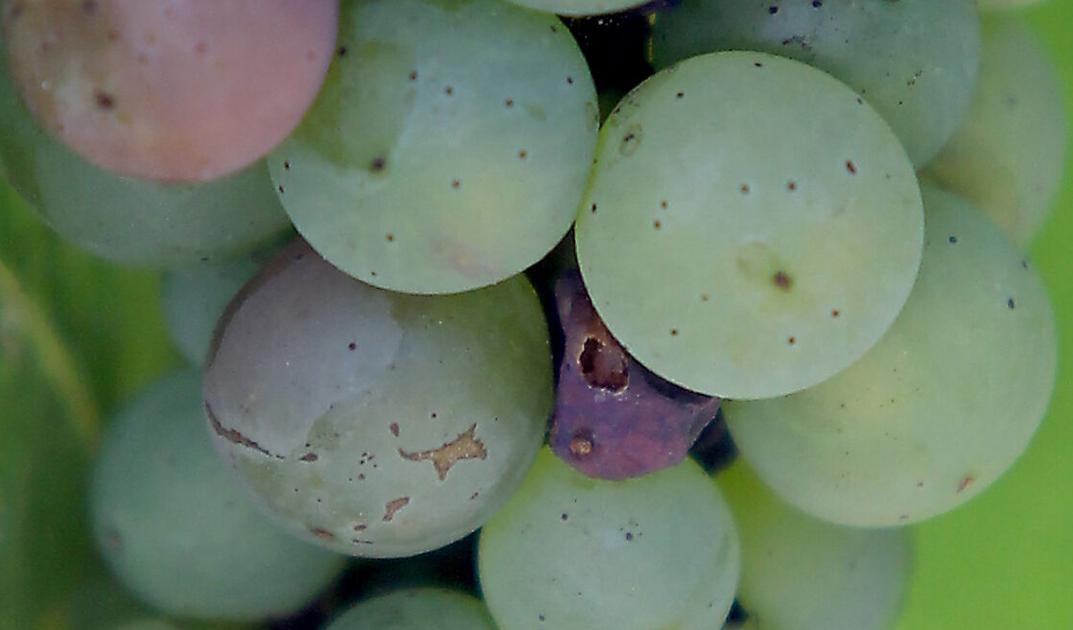
TRAVERSE CITY — Researchers at Michigan State University are studying the effects on vines of a viticulture technique that can boost wine production in our state’s relatively cool climate. They are partnering with Brys Estate Vineyard and Winery on Old Mission Peninsula, which has been using the technique since 2014.
“I’ve done early leaf removal for quite a few years now,” said Brys Estate winemaker Coenraad Stassen.
Early leaf removal involves using jets of compressed air to blow some leaves off the vines early in the season. Most growers, Stassen said, do the same thing late in the season — before draping the plants in nets to keep birds out — to give more light to the fruit and accelerate ripening.
Brys removes only the leaves in the 12- to 15-inch zone around the grapes early in the season, while allowing leaves higher on the plant to remain. Early season removal offers two benefits, Stassen said.
First, it deliberately causes heat stress on the plants by exposing the grapes to more sunlight and warmer temperatures. The additional stress can result in grapes ripening earlier and producing more sugars. Second, the removal allows more air flow through the grape clusters all summer, reducing the chance of mildew, rot and other problems.
“By doing early leaf removal, you’re exposing the fruit to sun, but you’re also opening the canopy,” said Stassen. “So when you get a lot of moisture, it helps prevent powdery and downy mildew because you have air flow going through the clusters.”
“Normally, the rule of thumb is that you want five to 10 leaves above your fruit zone. Because our canopy is almost 10 feet tall, we get at least 15 or 20 leaves above the fruit zone.”
“If you attack the cluster with high temperatures and a lot of light at the beginning of the season, you improve fruit quality a lot,” Paolo Sabbatini, associate professor in the Michigan State University Department of Horticulture said in a release. “The grapes ripen earlier, and they have more sugars, they have more color, they have all the compounds that we like in wine.”
Michigan’s grape growing season runs roughly May through October. Growers in California and the Mediterranean region have longer growing seasons. A shorter season translates into more chance for delayed fruit maturation, potential damage to vines and a limited amount of time for the grapes to ripen.
“Michigan is really a different place to grow grapes than any other place in the world,” said Sabbatini. “However, we have the potential to produce very outstanding wines. Unfortunately, the season variability and climate challenges often limit this.”
Sabbatini, along with Ilce Medina Meza, assistant professor in the MSU Department of Biosystems and Agricultural Engineering, is leading a three-year, $500,000 U.S. Department of Agriculture National Institute of Food and Agriculture project, testing alternative canopy management strategies to help Michigan wine producers grow grapes with high-quality aroma, color, bitterness and mouthfeel properties from the most important red cultivars planted in Michigan: pinot noir, cabernet and merlot.
“I feel very fortunate to have the research in our backyard and getting immediate feedback,” Stassen said.
On-site research for the project will be conducted at Brys Estate Winery in Traverse City. Samples of flowers, leaves and fruit from Brys Estate will be brought back to a lab, where Medina Meza will analyze tests to see the impact early leaf removal has on the compounds in the grapes. The project’s goal is to assess how early leaf removal affects the overall plant.
“This is a perfect project to demonstrate the importance of working across disciplines. Paolo is applying the agricultural practices, while I’m working to understand more about the physiology of the grapes,” Medina Meza said in the release. “It’s a great thing to bring together different expertise to see how the plants adapt or react to early leaf removal.”
Sabbatini said early leaf removal is a variation of a classical cool-climate viticulture technique used in northern Germany and New Zealand.
“Every year, growers see new improvement, more yield in the field, they see more red wines as the final product,” Medina Meza said. “I think we are making a huge impact in that regard, especially if this technique can be translated to other cool climate regions around the world, including the rest of the U.S. Midwest.”
The Link LonkJune 23, 2021 at 09:15PM
https://ift.tt/35Nuu0E
Grape leaves: Researchers study leaf removal technique | Business - Traverse City Record Eagle
https://ift.tt/3eO3jWb
Grape

No comments:
Post a Comment